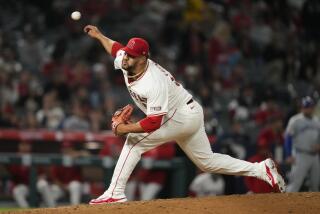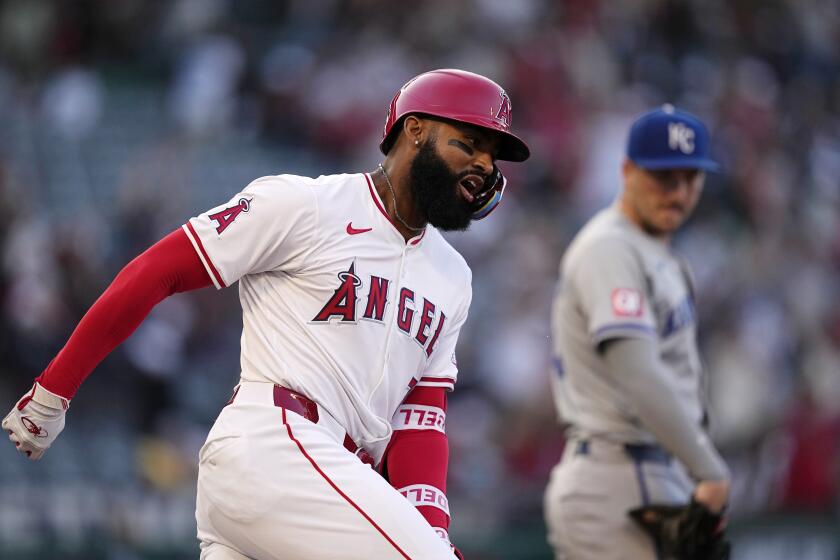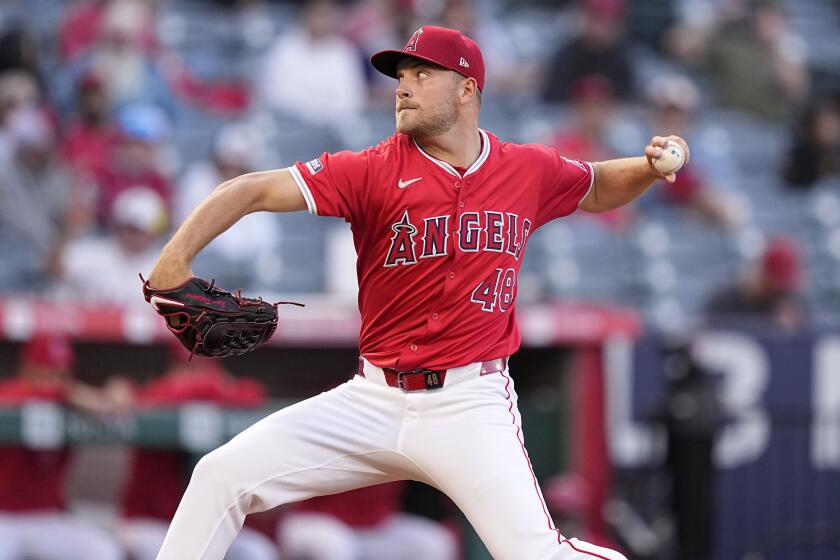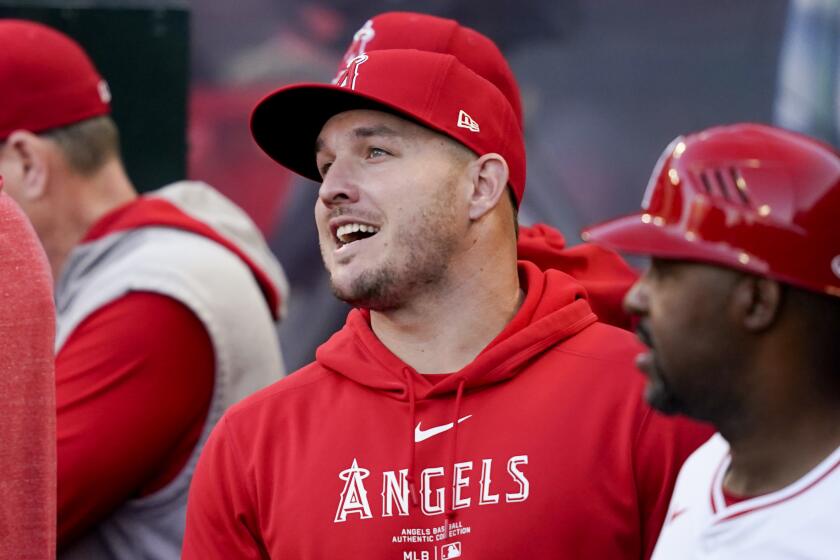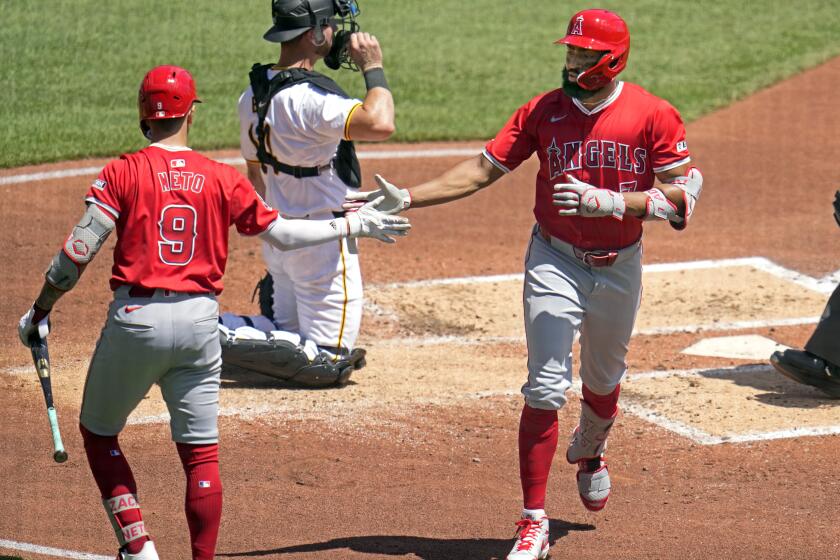Versatility defines Angels’ Kevin Frandsen and Dodgers’ Jamey Carroll
Kevin Frandsen got up slowly after slamming into Chicago Cubs shortstop Starlin Castro’s knee while stealing second base Sunday — and the Angels’ bench held its collective breath.
Frandsen, who was claimed off waivers from the Boston Red Sox in April, is probably the player the Angels can least afford to lose right now.
The utility player has been the starting third baseman since super-utility player Maicer Izturis went on the disabled list last week. Frandsen is also the backup shortstop and second baseman, and he can fill in at first base and the corner outfield spots too.
“Fans want to see the starters, but the utility player is the most important piece you can have,” Angels center fielder Torii Hunter said. “When a starter is tired or banged up, you’ve got to have faith that these guys can hold it down and come through in the clutch.
“They have to be mentally and physically strong enough to get the job done. We really appreciate guys like Frandsen, Izturis and [Robb] Quinlan. They step in and get the job done. The fans who don’t know the game don’t appreciate them.”
Most fans think of utility players as guys who aren’t good enough to be everyday players, but as Izturis has proved and the Dodgers’ Jamey Carroll is proving now, they are guys who are good enough to play every day at more than one position.
Angels Manager Mike Scioscia said Izturis has Gold Glove potential at shortstop, second base and third base. In 2009, Izturis also provided significant offense while rotating among the three spots, batting .300 with eight home runs, 65 runs batted in and 74 runs in 387 at-bats.
Izturis, who is so valued the Angels signed him to a three-year, $10-million deal last winter, has started only 27 games this season, but the Angels are 17-10 in those games.
Carroll, who was signed to a two-year deal over the winter by General Manager Ned Colletti, opened the season in a utility role but also started 32 games at shortstop in place of Rafael Furcal, who was on the DL for most of May and is now on baseball’s bereavement list.
The 36-year-old Carroll begins Tuesday’s interleague game at Angel Stadium with a .274 average, .385 on-base percentage — 28 walks and 30 strikeouts — and 10 RBIs. He has started seven games at second base and four at third base and has made only four errors. The Dodgers are 24-18 in the games he has started.
“I heard good things about him when Ned mentioned his name this winter,” Dodgers Manager Joe Torre said. “Everybody who’s had him on their club has given him good marks.
“I remember calling him after we made the deal. You sort of sensed the excitement in his voice. He’s been terrific. The thing we didn’t know in spring training that we’re finding out now is that he can play shortstop on a regular basis.”
Frandsen, who came up with the San Francisco Giants as a second baseman, looked a little shaky in his first three starts at third base for the Angels, committing errors in each game. Yet, he has played errorless ball in his last 15 starts — two of them at first base, a position he hadn’t started at in the big leagues until last week — and is batting .352 with six doubles.
“To me, a utility player is a guy who knows his role, who is able to play a lot of positions and take on a lot of responsibilities and can limit mistakes,” Frandsen, 28, said. “You’re a stopgap for the starter, and you don’t want there to be a big drop-off to the backup.
“It’s hard as a young player to get adjusted to it because you want to play every day. But when you accept it, you become better at it.”
Chone Figgins was the gold standard for utility players when he came up with the Angels, starting at six positions and moving with ease from the infield to the outfield before moving to third base full time in 2006.
Scioscia puts Izturis in the same class because of his defensive prowess. Carroll and Frandsen are not as athletic as Figgins, but they are just as versatile. Frandsen has started at all four infield spots and the corner outfield spots, and Carroll has played three infield spots and the corner outfield positions.
“Being a bench player is a state of mind,” Torre said. “Some guys physically can’t handle it. Like with [Blake] DeWitt. Not the bench player part, but the fact that we switched him back and forth and had him play second, short and third” last year.
“He wound up with an arm issue,” Torre said. “That’s different than the willingness to do stuff, which DeWitt’s always been. Jamey, he just seems to know his body, knows what he can do and knows what type of practice he has to go through.”
For a super-utility player, the daily pregame routine can be almost as challenging as a game.
“I take ground balls at every position every day,” Carroll said. “I don’t know where I’m going to be, so I have to be ready. I can be at any position at any point in time. It’s a matter of going in and being comfortable each day. You have to prepare.
“It’s hard switching from one position to another because each one of them has a different aspect to it.”
This spring, Frandsen picked the brains of veterans such as Tony Graffanino, who was in the Cleveland Indians’ training camp, and Marco Scutaro, the Red Sox shortstop, for utility tips.
“Their blueprint was to really simplify everything,” Frandsen said. “I pick two positions a day and work at those. It makes everything that much easier when you keep it simple.”
Clicking on Green Links will take you to a third-party e-commerce site. These sites are not operated by the Los Angeles Times. The Times Editorial staff is not involved in any way with Green Links or with these third-party sites.
More to Read
Go beyond the scoreboard
Get the latest on L.A.'s teams in the daily Sports Report newsletter.
You may occasionally receive promotional content from the Los Angeles Times.
